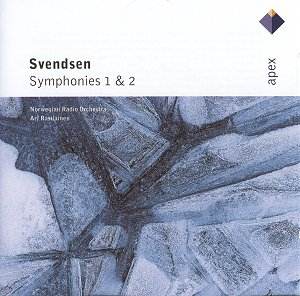I was recently guest-conducting in Germany, Sondershausen
near to Hannover to be precise, the opening concert of a festival of
the music of Bruch, who conducted there for three years between 1867
and 1870. Chatting in the break during one of the rehearsals with some
members of the orchestra we were hard put to name significant composers
of symphonies from about 1856 to 1876, say from the death of Schumann
to the appearance of Brahms’ first. There appears to be, as far as this
particular musical form is concerned, a Black Hole for about twenty
years. Bruch’s first two are there (1868 and 1870), Bruckner is beginning
(but unknown), Gounod penned a couple of rather lightweight examples
in the mid- and late 1850s, Sullivan’s (1866) is not to be dismissed
but neither is he remembered for it (perhaps W S Gilbert should have
written words to its finale). There’s Gade, Reinecke, Raff, Saint-Saëns
(only his second), Rubinstein, Borodin, and Rimsky-Korsakov, though
the latter tends to titles such as ‘Antar’ thus hovering on the symphonic
poem, which (especially in the case of Liszt's Dante and Faust)
cannot be included. George Bernard Shaw raved about Hermann Goetz’s
symphony which just makes it (1875), but fine though it is, it doesn’t
compare with the established masters on either side of the Black Hole.
The point is, I think, made, but the Norwegian Johan
Svendsen turns out to be a bit of a dark horse. Much of his orchestral
writing is confined to rather short, inconsequential orchestral rhapsodies,
some other miscellaneous works averaging five to twelve minutes, a violin
concerto and a cello concerto, and the two symphonies featured here,
the first a student work dating from 1867, the second from 1876, steam-rollered
by Brahms’ first in the same year. Johan Svendsen was conductor of the
Oslo Musical Society (1872-77, 1880-83), and of the Royal Theatre Orchestra
in Copenhagen (1883-1908). Acknowledged as one of the leading conductors
of the day, he did much to enliven the musical life of the two capitals
in which he worked. His music is always colourful, tuneful in the more
reflective slow movements, at its best in sparkling scherzos (the highlight
of both symphonies) in which the woodwind chatter along. They are both
rather prone to counterpoint in the outer movements (somehow one always
gets the feeling that a fugue is threateningly just around the corner)
so producing a somewhat stodgy result. His ability to orchestrate is
unquestioned, but he does not advance the cause of the symphony, and
especially not its finale problem.
In the 1970s the Norwegian Cultural Fund released six
LPs of his complete orchestral output under the NKF label, Naxos have
five CDs in their current catalogue (the two symphonies recorded by
the Bournemouth Symphony Orchestra under Bjarte Engeset and given a
high rating in the Penguin Guide), but this one by the Norwegian Radio
is a commandingly attractive performance, particularly in the rustic,
witty scherzettos of both symphonies in the style of the traditional
Norwegian dance called the Halling, with its bustling energetic playing
by the excellent woodwind section. An attractive buy.
Christopher Fifield

